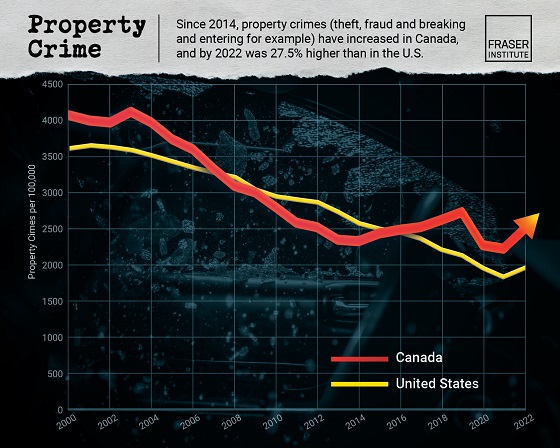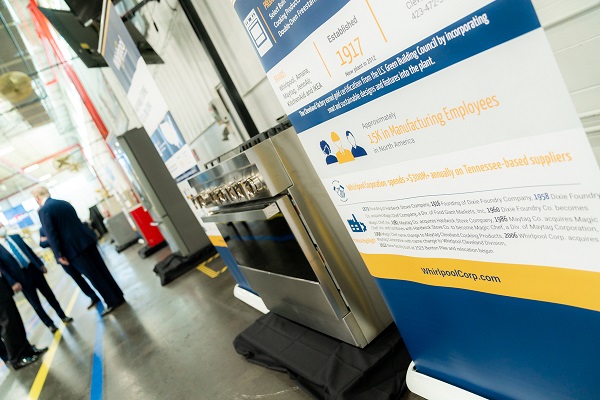Crime
Canada’s violent crime rate 14.0% higher than U.S. in 2022, and rising; property crime rate 27.5% higher

From the Fraser Institute
By: Livio Di Matteo
Rates of both violent crime and property crime (population adjusted) have been increasing in Canada in recent years, and now surpass comparable crime rates in the United States, finds a new study published today by the Fraser Institute, an
independent, non-partisan Canadian public policy think tank.
“This idea that Canada is much safer than the United States is not supported by the data as rates of property and violent crime in Canada are now higher than south of the border,” said Livio Di Matteo, a senior fellow at the Fraser Institute and author of an upcoming study Comparing Recent Crime Trends in Canada and the United States: An Introduction.
The chapter released today, the first of a larger upcoming study examining crime rates between the two countries, focuses on national comparisons. It finds that from 2014 (a year when crimes rates reached their lowest) to 2022 (the most recent comparable year of data), the violent crime rate in Canada increased by 43.8 per cent to 434.1 violent crimes per 100,000 people. That’s now 14 per cent higher than the violent crime rate in the U.S., which only increased 5.3 per cent over the same period to 380.7 violent crimes per 100,000 people.
Violent crime data in Canada differs from the United States, so adjustments were made to ensure as high a level of comparability as possible. The adjusted violent crime data includes murder, robbery, and assault with a weapon.
Additionally, the rate of population adjusted property crimes (e.g., burglary, theft, motor vehicle theft) is also now 27.5 per cent higher in Canada than in the U.S., with 2491.0 crimes occurring per 100,000 people in Canada in 2022—a 7.0 per cent
increase from 2014. By contrast, the property crime rate in the U.S. declined by 24.1 per cent over the same period to 1954.4 crimes per 100,000 people.
Crucially, homicides are also on the rise in Canada with the number of murders increasing from 1.5 per 100,000 in 2014 to 2.3 in 2022—a 53.4 per cent increase. The homicide rate in the U.S. remains markedly higher than in Canada at 5.8 per 100,000 people in 2022 and increased 49.4 per cent from 2014 to 2022.
“Crime rates in Canada, which are still historically low, are nevertheless rising and, in some cases are higher than in the U.S., which should concern Canadians,” Di Matteo said.
- This is a pre-release of an upcoming study examining crime rates between Canada and the United States.
- This first chapter focuses on national comparisons, and finds that from 2014 (a year when crimes rates reached their lowest) to 2022 (the most recent comparable year of data), rates of both violent crime and property crime (adjusted for population) have been increasing in Canada and now surpass comparable crime rates in the United States.
- From 2014 to 2022, the violent crime rate in Canada increased by 43.8 per cent to 434.1 violent crimes per 100,000 people.
- The violent crime rate in the U.S. increased 5.3 per cent over the same period to 380.7 violent crimes per 100,000 people.
- Likewise, the rate of population-adjusted property crimes (e.g., burglary, theft, motor vehicle theft) is also now higher in Canada than in the U.S., with 2491.0 crimes occurring per 100,000 people in Canada in 2022—a 7.0 per cent increase from 2014.
- By contrast, the property crime rate in the U.S. declined by 24.1 per cent over the same period to 1954.4 crimes per 100,000 people.
- Homicides are also on the rise in Canada with the number of murders increasing from 1.5 per 100,000 in 2014 to 2.3 in 2022—a 53.4 per cent increase.
- The homicide rate in the U.S. remains markedly higher than in Canada at 5.8 per 100,000 people in 2022 and increased 49.4 per cent from 2014 to 2022.
Banks
“Trade-Based Money Laundering IS THE FENTANYL CRISIS”: Sources expose Chinese-Mexican-Canadian Crime Convergence

Prime Minister Justin Trudeau attends a dinner at the home of a United Front Work Department leader in Vancouver.
‘That famous picture of Trudeau at a Vancouver dinner with all those Chinese guys—They’re all in there’: Source on United Front money laundering suspects surveilled by US Agency
VANCOUVER and TORONTO — As debate rages over President Donald Trump’s disruptive tariffs on Canada, Mexico, and China—whether they represent a genuine war on fentanyl deaths tied to each nation’s role in the deadly supply chain, or merely a pretext for U.S. trade dominance—multiple Canadian and U.S. government sources have stepped forward to highlight a factor they believe North American citizens aren’t grasping amid Trump’s political rhetoric.
They point to the staggering scale and sophistication of trade-based money laundering orchestrated by Chinese Triads in Canada and Mexican cartels. This is a predominant concern in Canada, alongside revelations of so-called fentanyl superlabs hidden in rural areas, yet easily supplied by Canadian transportation hubs—shipping, rail, and trucking networks saturated with organized crime. These sources insist this little-understood form of criminal money laundering not only fuels fentanyl trafficking—ultimately linked to a complicit Beijing—but directly finances drug shipments initiated by Chinese networks in Toronto and Vancouver, sending fentanyl, methamphetamine, and cocaine across the Mexican border into California, specifically to trucking hubs around Los Angeles.
According to the primary source—a Canadian expert familiar with what they classify as an intricate trilateral partnership between Chinese Triads, the Chinese Communist Party’s United Front foreign influence networks, and Latin American cartels—these economic networks have effectively infiltrated multiple industries and commodities markets on Canada’s and Mexico’s west coasts, using them to conceal and amplify proceeds from fentanyl transactions.
In 2023, Canada’s financial watchdog, Fintrac, reported that Chinese networks had evolved beyond traditional casino-based laundering methods in Vancouver and Toronto, now mastering laundering through Canadian banks, law offices, real estate, and diaspora-based fraud networks. Yet according to The Bureau’s criminal intelligence source, these same networks—operating alongside the Sinaloa Cartel—also traffic in a range of commodities, from poached wildlife and agricultural staples like avocados and limes to rare Chinese delicacies such as geoduck, a phallic-shaped clam prized in hot pot and believed to have aphrodisiac properties.
The same source contends that while Canadian government agencies—including the RCMP, Fintrac, CBSA, and CSIS—understand the key players in the fentanyl trade, systemic issues within Canadian policing and prosecution allow these networks to operate with near impunity:
“The RCMP knows they have no framework within the Criminal Code, no resources, and no support from prosecution services. They just have no ability. And this whole thing with Trudeau saying that only 43 kilos of fentanyl—less than one percent—is coming from Canada is such a joke. It’s the interweaving of trade-based money laundering—if the public knew, it would blow their minds. I believe the U.S. government and Trump know it, and that’s why he’s doing what he’s doing.”
Put another way, what this expert and others argue is that the drug and trade wars engulfing the United States and China are not polarities—they are a single, intertwined conflict, with trade-based money laundering as the critical convergence. And the growing concern—that Canadian and Mexican governments might be benefiting from this illicit trade, perhaps even to the point of complicity—cannot be entirely dismissed.
The exposure of Canada’s prime minister to money laundering networks presents a layer of intrigue and troubling optics, likely recognized in Washington, according to four sources across Canada.
The primary source for this story—reinforcing explosive claims by other Canadian police experts in a recent investigation by The Bureau—provided specific new details, identifying major money laundering networks in Vancouver of concern to U.S. authorities. Among them were high-profile suspects openly acknowledged at a fundraising event attended by Prime Minister Justin Trudeau.
Specifically, the source identified Chinese individuals who had entered Canada on a private jet flagged by a U.S. government agency, which asked the RCMP to surveil them in Vancouver. These suspects were linked to a commercial real estate investor in Vancouver with direct ties to Beijing, and to organized crime figures connected to Beijing’s United Front in Canada.

The gates of an RCMP targeted property in Richmond, British Columbia.
The same individuals, notorious in elite Canadian enforcement circles, appeared in suspicious transaction reports and were central to a sweeping police intelligence investigation into vulnerabilities in Canada’s banking system. This investigation, known as Project Athena, was a major anti-gang initiative examining reports from Canada’s financial intelligence agency, Fintrac. Project Athena emerged after the collapse of its predecessor case, E-Pirate—reportedly Canada’s largest-ever drug money laundering probe—which targeted Chinese underground bankers in Vancouver and Toronto linked to the Sam Gor network, a Chinese syndicate dominated by the 14K, Big Circle, and Sun Yee On Triads.
As part of Project Athena, investigators uncovered a single money service bureau in Hong Kong that moved CAD $973 million over three years, primarily through Canadian banks. Several United Front and Triad-linked suspects from earlier investigations were tied to these transactions.
“That famous picture of Trudeau at a Vancouver dinner with all those Chinese guys—the ones we all know from various media reports? They’re all in there. They’re all in there moving money around,” the source said. “And this was just one money service bureau. Nearly a billion dollars in three years. So how many others are there?”
 |
Paul King Jin and a number of Toronto and Vancouver-based Sam Gor associates targeted in the E-Pirate probe survived a 2020 gang execution in a Richmond sushi diner; Jin’s alleged underground banking partner Jian Jun Zhu was shot to death.
Buttressing their case, the source pointed to a remarkable cache of technical evidence seized from an underground casino in Richmond, just south of Vancouver, detailing the complexity of trade-based money laundering.
The evidence came from a mid-level Chinese Triad operative working for one of the underground banking bosses exposed in the RCMP’s E-Pirate probe of Sam Gor’s casino money-laundry networks.
In this subsequent investigation into Richmond-based underground casinos, investigators uncovered over 1,000 messages—texts, videos, and calls—confirming what Canadian authorities had long suspected and what American intelligence had warned about: the convergence of Triads and Mexican cartels.
In a microcosm, a mid-level Sam Gor agent in Vancouver and their Mexican cartel counterpart, coordinating major transborder narcotics and money laundering schemes, exemplified how Chinese and Mexican transnational networks dominate North American fentanyl trafficking.
Beyond coded drug negotiations, the messages revealed a broad trafficking scheme involving food and various commodities. As the law enforcement source explained, Triads and cartels exploit these commodities to launder illicit profits, amass market share, and tighten their grip on global supply chains.
The conversations demonstrated how narcotics could be smuggled across the border into California as easily as fresh produce or seafood was funneled into international markets.
“It was stunning, absolutely stunning to see coded drug talk, of course, all of that, the usual stuff that we expected to see—how they were going to get it shipped over the border in Mexico, that they had the ability to deliver into the Los Angeles area just north of Los Angeles,” the Canadian expert recalled. “And they would pick it up at these huge truck stops and they would specify in detail which vehicle. But what was equally stunning, was the fact that these two guys were also involved in a wide array of other items, consumer goods, everything from avocados to limes to geoduck clams to lobster, to anything that made a buck and allowed them to launder funds and to move capital through the system. They were trade-based money laundering experts.”
It was similar to the phenomenon seen domestically with Hells Angels in Vancouver infiltrating trucking and construction—but now expanded internationally via cartels and Triads, triangulating trade between China, Mexico, and Canada, the source argued.
The Triads and cartels use false invoicing and front companies, trade-money laundering experts say, securing meth and fentanyl shipments into the United States in exchange for sending legal commodities to Mexico or China. Drug shipments are often concealed within legitimate and counterfeit goods manufactured in China.
“And so they start taking over industries. That’s why your price of limes is what it is today—because the cartels have cornered the market, trying to put those drug proceeds somewhere. So let’s start buying up commodities and controlling sectors. And that’s what this case was. It confirmed everything we had received and heard from the FBI and DEA in bulletins for many years.”
The source added that while this particular cache of communications involved methamphetamine and cocaine—referred to as “glass” and “girls” in coded narco communications—it did not directly pertain to fentanyl. However, the Triad operator and the Mexican cartel associate appeared to broach the subject, at which point the cartel operative redirected the Canada-based Triad to another handler in Mexico.
“The cartel guy he was speaking with on this particular phone was the one handling coke and meth,” the source said. “So it’s like, ‘Hey, I’m interested in this.’ ‘Oh, I don’t deal with that. That’s my associate. You’ll have to go through someone else.’ They segment it. It’s just such a tapestry—but we’re still asleep at the wheel here.”
 |
Prime Minister Justin Trudeau attends a dinner at the home of a United Front Work Department leader in Vancouver.
Disclosing the stunning connections and scale of Triad influence on Canada’s West Coast, the source said the “underling” whose device was seized—revealing hundreds of money laundering and drug transaction deals between the Triad and a Mexican cartel—was working for one of the targets in the E-Pirate investigation, a Vancouver underground banking boss.
That same boss was tracked by the RCMP in another shocking and illustrative incident involving two Chinese airline pilots passing through Vancouver who were caught smuggling bear-paw parts. Like any other travelers, the Chinese pilots underwent standard security checks and were found carrying contraband poached in Canada. Parts from bears—and even massive polar bear mounts harvested from northern Canada—are sold for significant profits to Chinese buyers, the expert explained.
In this case, when the Chinese pilots were released from jail, the individual who arrived to collect them was an underling of the E-Pirate underground banking boss—a major figure in Chinese organized crime in North America. This individual is also said to be responsible for the large-scale export of luxury vehicles from Vancouver to China, the Canadian expert said.
“We found out that a hundred-thousand-dollar Mercedes here in Vancouver is worth between three and five times that overseas. So there’s your money laundering right there.”
The process operates much like the drug-cash laundering schemes identified by U.S. experts, including former Trump administration senior investigator David Asher. Asher contends that the Department of Justice’s $3 billion USD TD Bank money laundering prosecution exposed how Chinese international students—under the direction of China’s United Front Work Department cells—were tasked with collecting and depositing drug cash into bank accounts, transforming illicit funds into real estate mortgages for powerful Chinese criminals operating behind the scenes.
A similar system using Chinese students operates in Vancouver’s luxury vehicle market and drug cash collection networks, a Canadian expert said, describing it as a “diversification” of narco-laundering.
“So imagine moving a hundred thousand dollars’ worth of capital here and walking away with a $400,000 net profit overseas,” the expert explained. “It’s perfect. Then you buy the chemicals, ship them to Mexico, make the meth, make the fentanyl, and move the product north through the States or by other routes. But that’s the part people are just not connecting and are not willing to contemplate.
“We’ve got to embrace the complexity of it all. Every conceivable way you can think of to move product—that’s what they’re doing. Land, sea, air. Because just like a good corporation or investor diversifies their financial portfolio to limit risk, the same logic applies to fentanyl trafficking.”
Meanwhile, Eastern Canadian counterparts agreed. One source—who could not be identified but has expertise in Canadian mortgage regulations and private due diligence on mortgage lending fraud—provided industry-based insight into the players involved in the RCMP’s Project Athena investigation and related Fintrac reports. These reports examined 48,000 pandemic-era banking transactions within the Chinese diaspora, involving Canadian banks and ‘money mule’ accounts—often fronted by Chinese students—used to fund fraudulent mortgages with funds wired from Hong Kong and China.
The industry source estimated that systemic fraud plagues the Greater Toronto real estate market. According to this source, up to 20 percent of home purchases involve fraudulent mortgage applications.
“I am the street-level witness of how banks finance criminal activity. Extrapolating my findings, the amount of money embedded in Canadian housing is enough to make one weep,” they said, estimating that more than CAD $1 trillion may have been laundered through Toronto real estate in this manner over the past 12 years.
 |
This Greater Toronto mansion was associated with the same Sam Gor Triad networks and United Front operatives active in Vancouver, police and intelligence sources say.
The source affirmed that their knowledge aligns with Fintrac’s findings on underground banking and diaspora lending, noting that beyond the Chinese migrant community, industry experts have identified similar investment and lending schemes within the Indian diaspora. Meanwhile, several Eastern Canadian police sources familiar with Fintrac’s findings on Chinese diaspora money flows—as well as large-scale vehicle theft and trade-based money laundering investigations—said they also believe Greater Toronto is a key money laundering and drug transport hub for the Triad-Cartel nexus, a concern Washington has expressed deep alarm over.
“One thing that isn’t being talked about on this side of the border in this recent activity is the pervasiveness of money laundering and its links to all of the criminality,” one police source said.
Another expert suggested that Greater Toronto could be the largest drug-trafficking market by volume in North America, adding that diaspora-based crime groups exert significant influence over all modes of transportation across Ontario, including air traffic. “So you have a few hundred more officers driving up and down the border routes now?” they said, chuckling derisively.
A U.S. government expert criticized Canada’s government and media—particularly reporting from The Globe and Mail that echoes Prime Minister Trudeau’s seizure data arguments—for failing to grasp the scale of fentanyl and illicit trade, calling the country’s focus on relatively small seizure data misleading.
This expert aligned with Canadian federal law enforcement officials who point to highly sophisticated, trade-based money laundering schemes linking Mexican cartels and Chinese Triad networks operating in Vancouver and Toronto. These networks, the U.S. expert explained, facilitate the cross-border flow of methamphetamine, cocaine, and fentanyl, using multi-commodity trade-based money laundering transactions to disguise their profits.
They suggested that Canada either lacks a full understanding of the issue or is failing to take U.S. concerns seriously. By not adopting a more forthright stance—particularly in assessing the scale of money laundering linked to illicit drugs and organized crime—they believe Canada is ultimately undermining its own interests. Meanwhile, U.S. authorities, they asserted, have a clearer and more comprehensive picture of the problem.
This could explain why, following his unexpected victory in the November 2024 election, President Donald Trump swiftly threatened tariffs on Canada and Mexico—a move that puzzled and stunned most observers.
Two Canadian sources suggested the decision was influenced, at least in part, by a bipartisan congressional report on fentanyl released in December.
“It’s certainly one of the most pressing and high-profile developments in the crisis,” one source said.
The congressional working group behind the report spent months expanding on the Select Committee’s bipartisan investigation, which, for the first time, documented how the Chinese Communist Party directly subsidizes the production of fentanyl precursors and analogues.
Lawmakers are now advancing three bipartisan bills aimed at bolstering law enforcement, expanding sanctions against Chinese-backed entities involved in drug trafficking, and imposing financial penalties on organizations that fail to enforce transparency measures to curb illicit drug flows.
“For too long, China has profited from the destruction of American lives, and the fentanyl crisis they are fueling knows no borders,” said Representative Dan Newhouse, chairman of the congressional working group. “As we continue fighting the immediate threat this drug poses, we are also going after the CCP and its central role in subsidizing, producing, and exporting the precursors that drive this epidemic.”
In response to Trump’s formal imposition of tariffs on Tuesday, Canada’s Finance Ministry issued a statement emphasizing the country’s efforts to combat fentanyl smuggling. “Less than 1 percent of fentanyl and illegal crossings into the United States come from Canada, yet the government launched a $1.3 billion border plan with new choppers, boots on the ground, more coordination, and increased resources to stop the flow of fentanyl,” the statement read.
That same day, U.S. Senator Jeanne Shaheen, ranking member of the Senate Foreign Relations Committee, issued a sharp rebuke of Trump’s economic policies following his joint address to Congress.
“President Trump’s address this evening laid bare a cynical and profoundly dangerous approach to America’s global leadership,” Shaheen said. “His 25 percent tariffs on Mexico and Canada—our closest trading partners—threaten to unravel decades of economic cooperation and will inevitably result in economic consequences for American workers and businesses.”
But a Canadian expert dismissed Canada’s efforts as insufficient.
“If you really want to do something lasting here—I mean, I don’t want to sound like I’m pro-Trump in that sense—but you’d have to have a leader in this country willing to crack open the Charter and the criminal code and make radical changes,” the expert said. “This is stuff Canada should have addressed 25 years ago. But through successive liberal governments, we’ve allowed it to continue, and now we’re caught with our pants down.
“If we think we can just start throwing numbers at this and that’ll fix it, that’s a mistake,” the expert continued. “The problem is the framework in Canada—it has made this attractive. The police know what’s going on, but they don’t have the tools to prosecute and disincentivize this. Trump knows this. Imagine it from his perspective: He’s surrounded by weaklings exploiting and killing Americans. He’s not wrong.”
Underscoring the paralysis of Canada’s federal police under the current legal framework, the source reiterated that a broken prosecutorial system not only fails to secure charges against entrenched Chinese and Mexican criminal networks but refuses to even consider cases.
“This is what happens when you’ve got such a decayed system—whether it’s the Charter of Rights, the Criminal Code, the prosecution services, or just the broader demoralization of policing, compounded by chronic resourcing issues for years,” the primary source for this story said. “They just go for the easy stuff. Anything complex—they don’t touch it. I don’t think they’ve tackled a serious file since the E-Pirate case collapsed. The prosecution service basically said, ‘Look, we’re dealing with the same resourcing issues. Don’t send us these complex files. We can’t handle anything with more than three names listed in your report.’”
The Bureau is a reader-supported publication. To receive new posts and support my work, consider becoming a free or paid subscriber.
Please support a public interest startup. We break international stories and this requires elite expertise, time and legal costs.
Crime
Reporter Exposed The Left’s $20 Billion Climate Slush Fund

From from undercover news report from Project Veritas

From the Daily Caller News Foundation
By Michael Bastasch
The Environmental Protection Agency (EPA) — yes, the agency that’s supposed to make sure the air and water is clean — has been caught red-handed in what, at least on the outside, looks like one of the most brazen and high-dollar left-wing political payouts of the century.
In what Trump EPA described in a letter to the agency inspector general’s office as “an unprecedented arrangement,” Biden-era bureaucrats used private Citibank bank accounts to squirrel away $20 billion in taxpayer funds — that’s right, billion with a “b” — much of which is earmarked for lefty “pass-through” organizations the agency itself determined “lacked basic financial competency.”
This $20 billion was ostensibly meant for “green banks” to finance all sorts of nice-sounding “climate justice” and green energy projects — but instead it steered billions upon billions to groups deeply tied into the Democratic Party machinery.
For instance, the current and former chairmen of one of the pass-throughs, called the Coalition for Green Capital (CGC), are both Democratic Party donors, each cutting sizable checks to Kamala Harris’ ill-fated 2024 run. CGC was on track to get $5 billion from Biden’s EPA.
In another case, a left-wing consortium tied to Stacey Abrams’s voter mobilization group was awarded $2 billion. In its letter to the IG, Trump’s EPA noted the former administration itself determined these groups “lacked basic financial competency,” but earmarked the cash anyway.
So, here we have billions in taxpayer funds being directed to Democratic insiders and donors — paging DOGE! No wonder bureaucrats shoveled this money into a seemingly untouchable Citibank account in the waning days of the Biden administration.
One former Biden EPA official was reportedly caught on tape gleefully comparing it to “tossing gold bars off the Titanic.”
Taken together, this looks like the left-wing political payout of the century. Rarely is rank political patronage so nakedly on display.
The U.S. Justice Department (DOJ) and FBI are currently asking tough questions of career EPA officials about these “gold bars,” but it’s unclear if the Trump EPA will be able to claw back any of the funds.
Accountability — after four years of virtually none of it — would not only be a victory for taxpayers, but also for good journalism.
It’s important to remember we’re only talking about this Biden EPA scandal because of the tireless efforts of one journalist. Long before the EPA inspector general, DOJ, the FBI, or even the Department of Government Efficiency, were alerted to this political payout, a reporter named Nick Pope was on the case.
Back in November 2023, when the Biden EPA announced it was handing out billions to so-called “green banks” in the name of “climate justice” and other high causes, Pope thought this might be the perfect cover for the Democratic Party to enrich itself at taxpayer expense.
No slouch, Pope dug in, and soon he saw smoke. Huge, billowing clouds of smoke. His first piece, published that same month, laid out in detail how the “green banks” on the shortlist for Biden EPA funding “all feature numerous individuals on their boards who work for influential organizations aligned with the Democratic Party or previously worked for Democratic administrations.”
But this was no one-off. Pope followed up when the EPA announced it was handing billions to the very groups he had just exposed as essentially being Democratic Party pass-throughs.
Government watchdog groups were put on alert. Congress eventually got involved, demanding answers from the Biden EPA about how something like this could even happen. Pope’s colleague Adam Pack left his own mark, first reporting about the billions going to the liberal consortium affiliated with Abrams’ get-out-the-vote efforts.
Even after the FBI got involved, Pope didn’t rest, pushing out yet another hard-hitting investigation exposing how heads of the groups slated to get billions in Biden bucks “collectively made hundreds of thousands of dollars in personal political donations to Democratic candidates and organizations in recent years.”
If Trump is actually able to claw back these “gold bars,” make sure to thank Nick Pope. Heck, even if we don’t get the money back, thank him anyway. Good journalism should be rewarded even if the ultimate outcome isn’t exactly what we wanted.
Besides, they don’t give out Pulitzers for exposing Democratic corruption, now do they?
While trust in media plummets, and the legacy press continues its liberal bootlicking, it’s even more important we support good journalists, like Pope and the rest of the Daily Caller News Foundation team, who are unafraid to report the truth and hold the powerful accountable.
Mike Bastasch is editor-in-chief of the Daily Caller News Foundation.
-

 Business7 hours ago
Business7 hours ago“The insanity is ending”: USDA cancels $600k grant to study transgender men’s menstruation
-

 National2 days ago
National2 days agoTrudeau says he will resign next week despite Trump’s claim he will stay in office
-

 Business1 day ago
Business1 day agoTaxpayers Federation demands government cancel automatic beer tax hike
-

 Business23 hours ago
Business23 hours agoApple suing British government to stop them from accessing use data
-

 Business1 day ago
Business1 day agoTrump’s first jobs report: Manufacturing roars back, reversing Biden-era losses
-

 Business2 days ago
Business2 days agoMark Carney’s fiscal plan: a marketing exercise to mask spending
-

 conflict2 days ago
conflict2 days agoEU leaders escalate war rhetoric with Russia in stark departure from Trump’s peace push
-

 Uncategorized2 days ago
Uncategorized2 days agoCanada Needs A Real Plan To Compete Globally






